A Numerical and Experimental Investigation on a Gravity-Assisted Heat-Pipe-Based Battery Thermal Management System for a Cylindrical Battery
Abstract
:1. Introduction
2. Modelling Methodology
2.1. Geometrical Model
2.2. Numerical Model
2.2.1. Governing Equations
2.2.2. Grid Independent Test
2.2.3. Initial and Boundary Conditions
2.2.4. Thermal Resistance Network Model
3. Model Validation
3.1. Experimental Setup
3.2. Experimental Procedure
3.3. Uncertainty Analysis
3.4. Experimental Validation
4. Results and Discussion
4.1. Effects of Coolant Flow Temperature and Input Power
4.2. Determination of High Temperature Range in HP-BTMS Thermal Resistance Model
4.3. Flow Pattern and Heat Transfer
5. Conclusions
- The design is capable of keeping a temperature difference among batteries under 5 °C when the volumetric flow rate and inlet temperature was maintained at 0.33 L/min and 25 °C, respectively.
- The maximum temperature was under 64 °C at the same test condition.
- The heat transfer rate is different on each heat pipe due to the flow pattern and the curved shaped copper sheet. As it was expected, the first, second and third heat pipes transferred slightly more heat power than the forth and fifth.
- The system level one dimensional thermal resistance network model was used to identify the regions of high thermal resistance in the system.
Author Contributions
Funding
Data Availability Statement
Conflicts of Interest
Nomenclature
| A | Abbreviations | ||
| C | TECM | thermal resistant network model | |
| Cp | PCM | phase change materials | |
| d | diameter (mm) | EVs | electric vehicles |
| H | BTMS | battery thermal management system | |
| h | |||
| I | discharge current (A) | Subscripts | |
| L | thickness (mm) | f | flow |
| l | length (m) | g | thermal grease |
| Nu | Nusselt number | h | heat pipe |
| Q | heat (W) | r | radial |
| U | voltage (V) | s | Shell of heat pipe |
| m | v | vapor | |
| Volumetric flow rate (L/min) | w | wick | |
| R | e | evaporation of heat pipe | |
| T | c | condenser of heat pipe | |
| V | |||
| Greek symbols | |||
| time (s) | |||
References
- Global EV Outlook 2022—Data Product—IEA. Available online: https://www.iea.org/data-and-statistics/data-product/global-ev-outlook-2022 (accessed on 10 April 2023).
- The Influence of Government Incentives on Electric Vehicle Adoption: Cross-National Comparison. Available online: https://www.researchgate.net/publication/348687386_The_Influence_of_Government_Incentives_on_Electric_Vehicle_Adoption_Cross-national_Comparison (accessed on 10 April 2023).
- Lang, J.; Zhang, X.; Liu, B.; Wang, R.; Chen, J.; Yan, X. The roles of graphene in advanced Li-ion hybrid supercapacitors. J. Energy Chem. 2018, 27, 43–56. [Google Scholar] [CrossRef]
- Specific Heat Capacity of Lithium Ion Cells—Battery Design. Available online: https://www.batterydesign.net/specific-heat-capacity-of-lithium-ion-cells/ (accessed on 27 March 2023).
- Rao, Z.; Wang, S. A review of power battery thermal energy management. Renew. Sustain. Energy Rev. 2011, 15, 4554–4571. [Google Scholar] [CrossRef]
- Zhang, F.; Lin, A.; Wang, P.; Liu, P. Optimization design of a parallel air-cooled battery thermal management system with spoilers. Appl. Therm. Eng. 2021, 182, 116062. [Google Scholar] [CrossRef]
- Saw, L.H.; Tay, A.A.O.; Zhang, L.W. Thermal management of lithium-ion battery pack with liquid cooling. In Proceedings of the 2015 31st Thermal Measurement, Modeling & Management Symposium (SEMI-THERM), San Jose, CA, USA, 15–19 March 2015; pp. 298–302. [Google Scholar] [CrossRef]
- Greco, A.; Cao, D.; Jiang, X.; Yang, H. A theoretical and computational study of lithium-ion battery thermal management for electric vehicles using heat pipes. J. Power Sources 2014, 257, 344–355. [Google Scholar] [CrossRef]
- Liu, C.; Xu, D.; Weng, J.; Zhou, S.; Li, W.; Wan, Y.; Jiang, S.; Zhou, D.; Wang, J.; Huang, Q. Phase Change Materials Application in Battery Thermal Management System: A Review. Materials 2020, 13, 4622. [Google Scholar] [CrossRef] [PubMed]
- Roe, C.; Feng, X.; White, G.; Li, R.; Wang, H.; Rui, X.; Li, C.; Zhang, F.; Null, V.; Parkes, M.; et al. Immersion cooling for lithium-ion batteries—A review. J. Power Sources 2022, 525, 231094. [Google Scholar] [CrossRef]
- Ling, Z.; Wang, F.; Fang, X.; Gao, X.; Zhang, Z. A hybrid thermal management system for lithium ion batteries combining phase change materials with forced-air cooling. Appl. Energy 2015, 148, 403–409. [Google Scholar] [CrossRef]
- Fan, Y.; Bao, Y.; Ling, C.; Chu, Y.; Tan, X.; Yang, S. Experimental study on the thermal management performance of air cooling for high energy density cylindrical lithium-ion batteries. Appl. Therm. Eng. 2019, 155, 96–109. [Google Scholar] [CrossRef]
- Chen, D.; Jiang, J.; Kim, G.-H.; Yang, C.; Pesaran, A. Comparison of different cooling methods for lithium ion battery cells. Appl. Therm. Eng. 2016, 94, 846–854. [Google Scholar] [CrossRef]
- Zhou, H.; Zhou, F.; Zhang, Q.; Wang, Q.; Song, Z. Thermal management of cylindrical lithium-ion battery based on a liquid cooling method with half-helical duct. Appl. Therm. Eng. 2019, 162, 114257. [Google Scholar] [CrossRef]
- Huo, Y.; Rao, Z.; Liu, X.; Zhao, J. Investigation of power battery thermal management by using mini-channel cold plate. Energy Convers. Manag. 2015, 89, 387–395. [Google Scholar] [CrossRef]
- Jiang, Z.; Qu, Z. Lithium–ion battery thermal management using heat pipe and phase change material during discharge–charge cycle: A comprehensive numerical study. Appl. Energy 2019, 242, 378–392. [Google Scholar] [CrossRef]
- Coleman, B.; Ostanek, J.; Heinzel, J. Reducing cell-to-cell spacing for large-format lithium ion battery modules with aluminum or PCM heat sinks under failure conditions. Appl. Energy 2016, 180, 14–26. [Google Scholar] [CrossRef]
- Wang, Z.; Zhang, H.; Xia, X. Experimental investigation on the thermal behavior of cylindrical battery with composite paraffin and fin structure. Int. J. Heat Mass Transf. 2017, 109, 958–970. [Google Scholar] [CrossRef]
- Wu, W.; Yang, X.; Zhang, G.; Chen, K.; Wang, S. Experimental investigation on the thermal performance of heat pipe-assisted phase change material based battery thermal management system. Energy Convers. Manag. 2017, 138, 486–492. [Google Scholar] [CrossRef]
- Mortazavi, B.; Yang, H.; Mohebbi, F.; Cuniberti, G.; Rabczuk, T. Graphene or h-BN paraffin composite structures for the thermal management of Li-ion batteries: A multiscale investigation. Appl. Energy 2017, 202, 323–334. [Google Scholar] [CrossRef]
- Zheng, M.; Liu, Y.; Ma, Z.; Li, Y.; Li, D.; Lu, Z.; Song, H.; Guo, X.; Shao, W. Numerical study on power battery thermal management system based on heat pipe technology. Energy Rep. 2023, 9, 350–361. [Google Scholar] [CrossRef]
- Hwang, F.S.; Confrey, T.; Scully, S.; Callaghan, D.; Nolan, C.; Kent, N.; Flannery, B. Modelling of heat generation in an 18650 lithium-ion battery cell under varying discharge rates. In Proceedings of the 5th Thermal and Fluids Engineering Conference (TFEC), New Orleans, LA, USA, 5–8 April 2020. [Google Scholar] [CrossRef]
- Ye, Y.; Saw, L.H.; Shi, Y.; Tay, A.A. Numerical analyses on optimizing a heat pipe thermal management system for lithium-ion batteries during fast charging. Appl. Therm. Eng. 2015, 86, 281–291. [Google Scholar] [CrossRef]
- Zhao, R.; Gu, J.; Liu, J. An experimental study of heat pipe thermal management system with wet cooling method for lithium ion batteries. J. Power Sources 2015, 273, 1089–1097. [Google Scholar] [CrossRef]
- Zhao, C.; Cao, W.; Dong, T.; Jiang, F. Thermal behavior study of discharging/charging cylindrical lithium-ion battery module cooled by channeled liquid flow. Int. J. Heat Mass Transf. 2018, 120, 751–762. [Google Scholar] [CrossRef]
- Wang, Q.; Jiang, B.; Xue, Q.; Sun, H.; Li, B.; Zou, H.; Yan, Y. Experimental investigation on EV battery cooling and heating by heat pipes. Appl. Therm. Eng. 2015, 88, 54–60. [Google Scholar] [CrossRef]
- Liang, J.; Gan, Y.; Li, Y. Investigation on the thermal performance of a battery thermal management system using heat pipe under different ambient temperatures. Energy Convers. Manag. 2018, 155, 1–9. [Google Scholar] [CrossRef]
- Gan, Y.; He, L.; Liang, J.; Tan, M.; Xiong, T.; Li, Y. A numerical study on the performance of a thermal management system for a battery pack with cylindrical cells based on heat pipes. Appl. Therm. Eng. 2020, 179, 115740. [Google Scholar] [CrossRef]
- Feng, L.; Zhou, S.; Li, Y.; Wang, Y.; Zhao, Q.; Luo, C.; Wang, G.; Yan, K. Experimental investigation of thermal and strain management for lithium-ion battery pack in heat pipe cooling. J. Energy Storage 2018, 16, 84–92. [Google Scholar] [CrossRef]
- Reay, D.; Kew, P.; McGlen, R. Heat pipe components and materials. In Heat Pipes; Elsevier: Amsterdam, The Netherlands, 2014; pp. 65–94. [Google Scholar] [CrossRef]
- Zichen, W.; Changqing, D. A comprehensive review on thermal management systems for power lithium-ion batteries. Renew. Sustain. Energy Rev. 2021, 139, 110685. [Google Scholar] [CrossRef]
- Drake, S.J.; Martin, M.; Wetz, D.A.; Ostanek, J.K.; Miller, S.P.; Heinzel, J.M.; Jain, A. Heat generation rate measurement in a Li-ion cell at large C-rates through temperature and heat flux measurements. J Power Sources 2015, 285, 266–273. [Google Scholar] [CrossRef]
- Smith, J.; Singh, R.; Hinterberger, M.; Mochizuki, M. Battery thermal management system for electric vehicle using heat pipes. Int. J. Therm. Sci. 2018, 134, 517–529. [Google Scholar] [CrossRef]

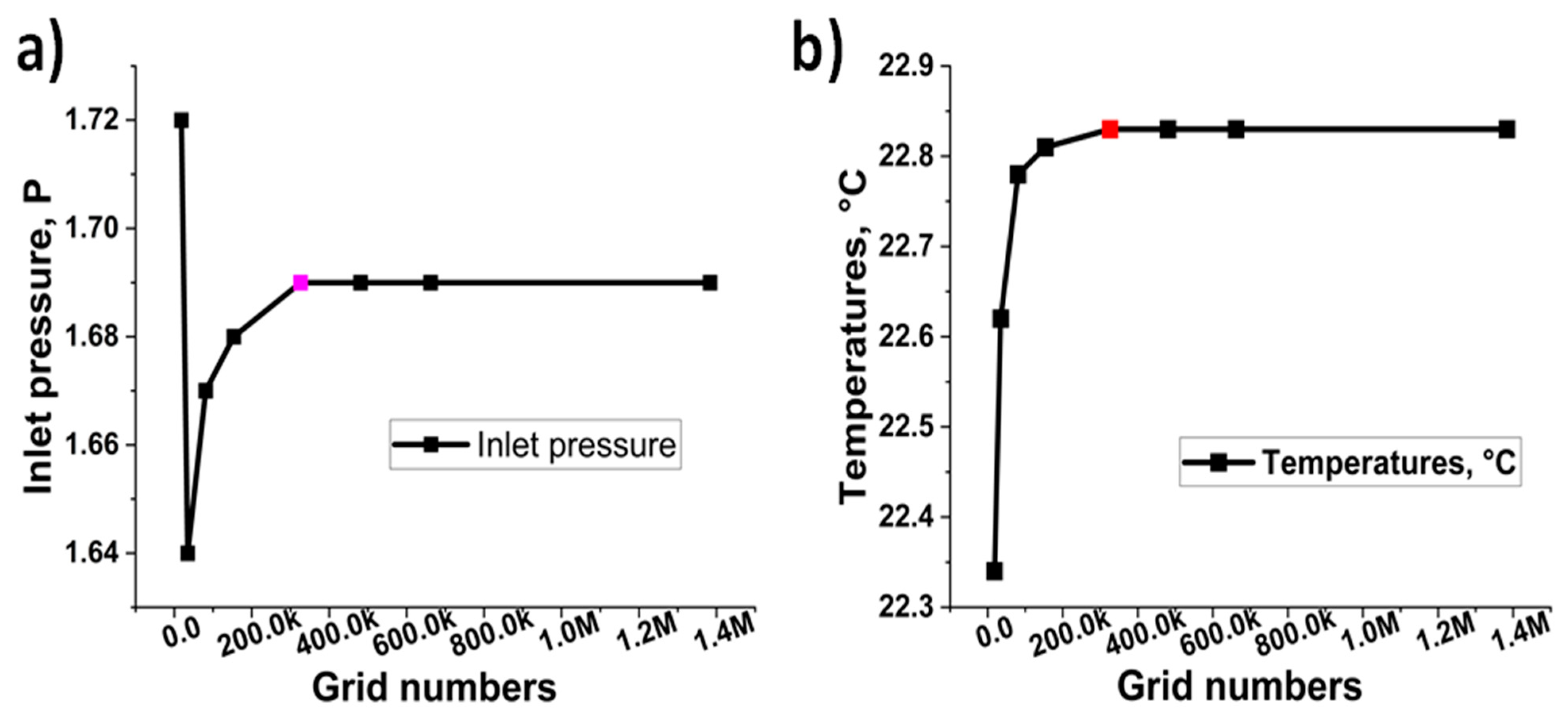
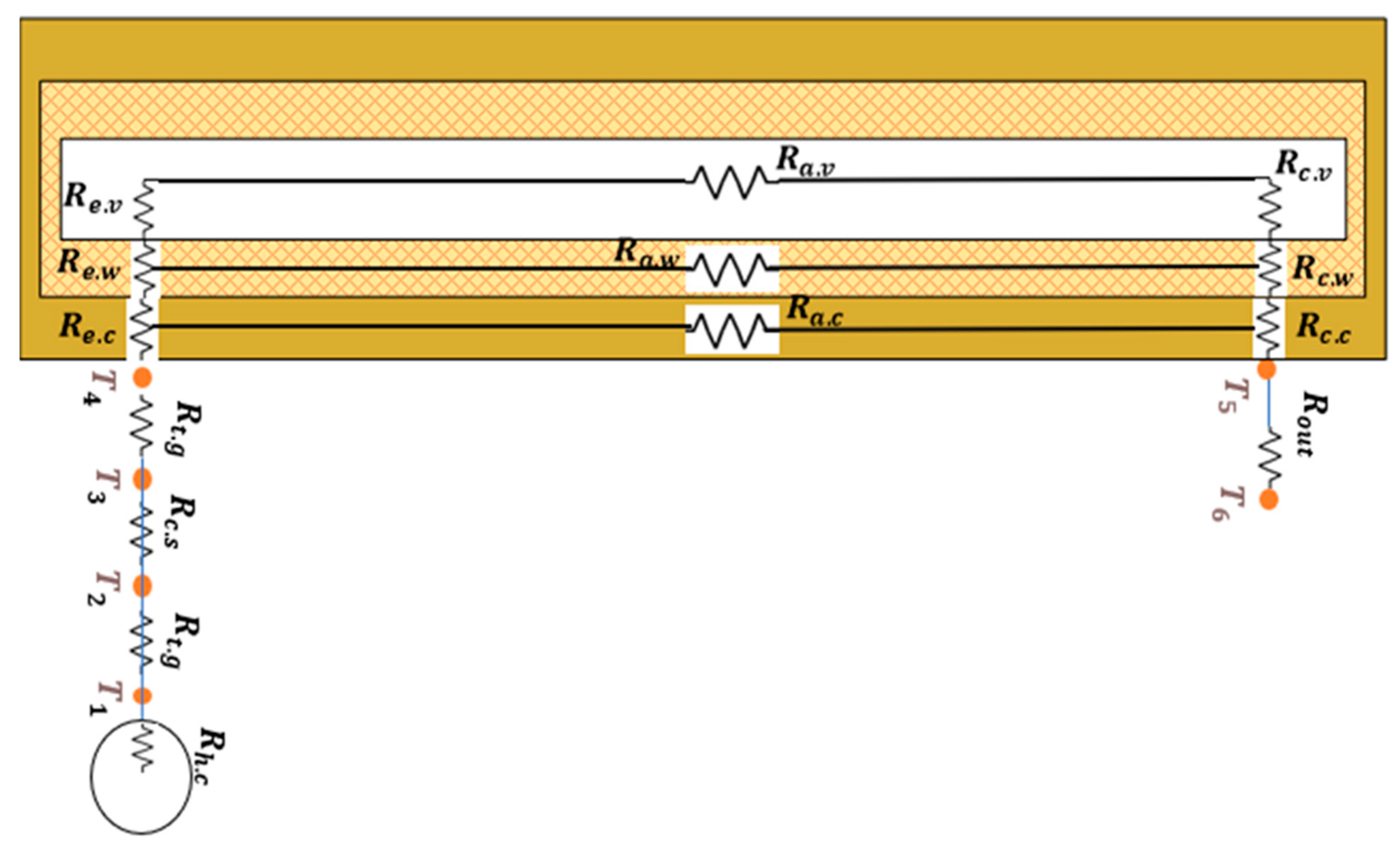
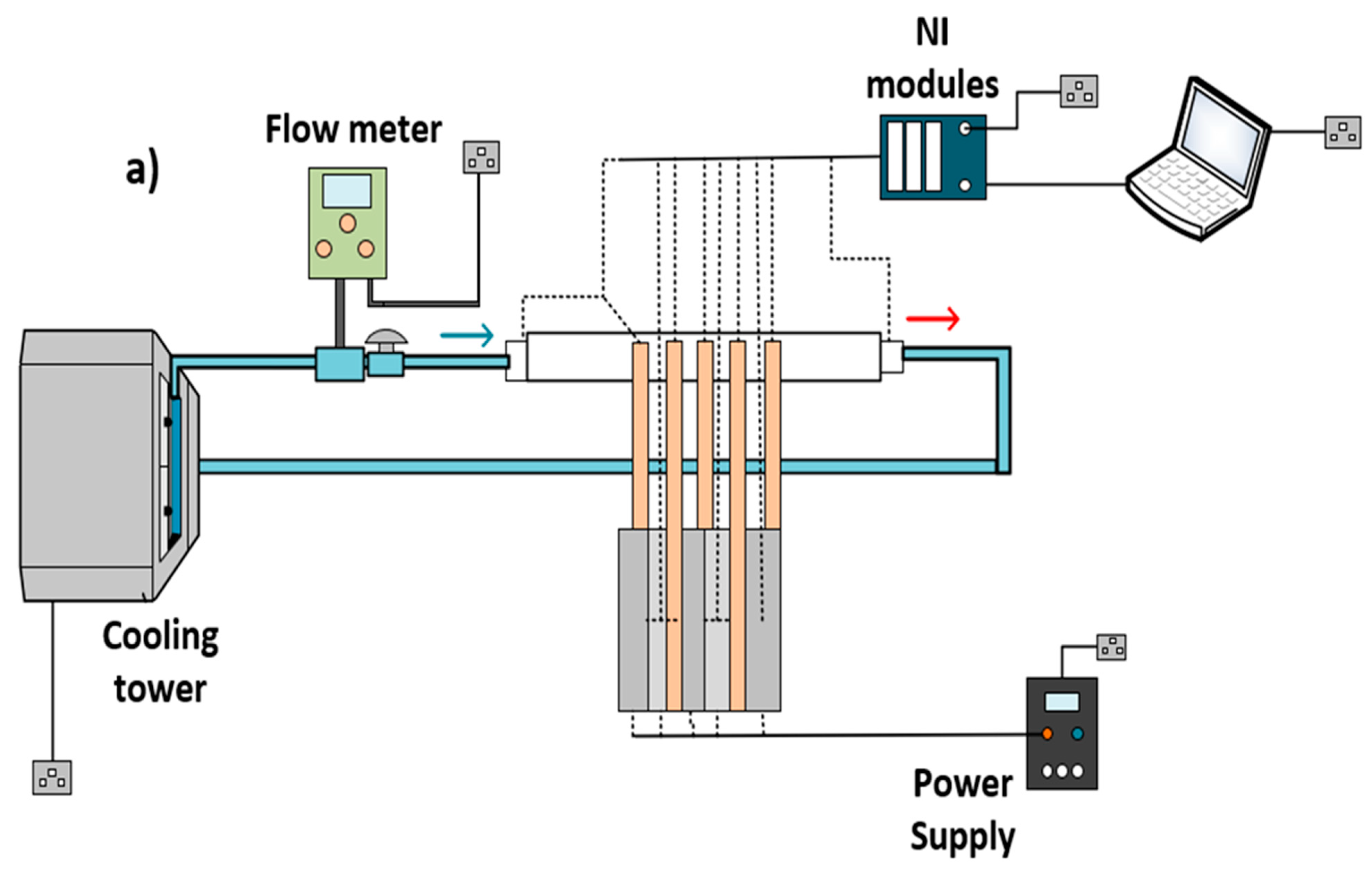
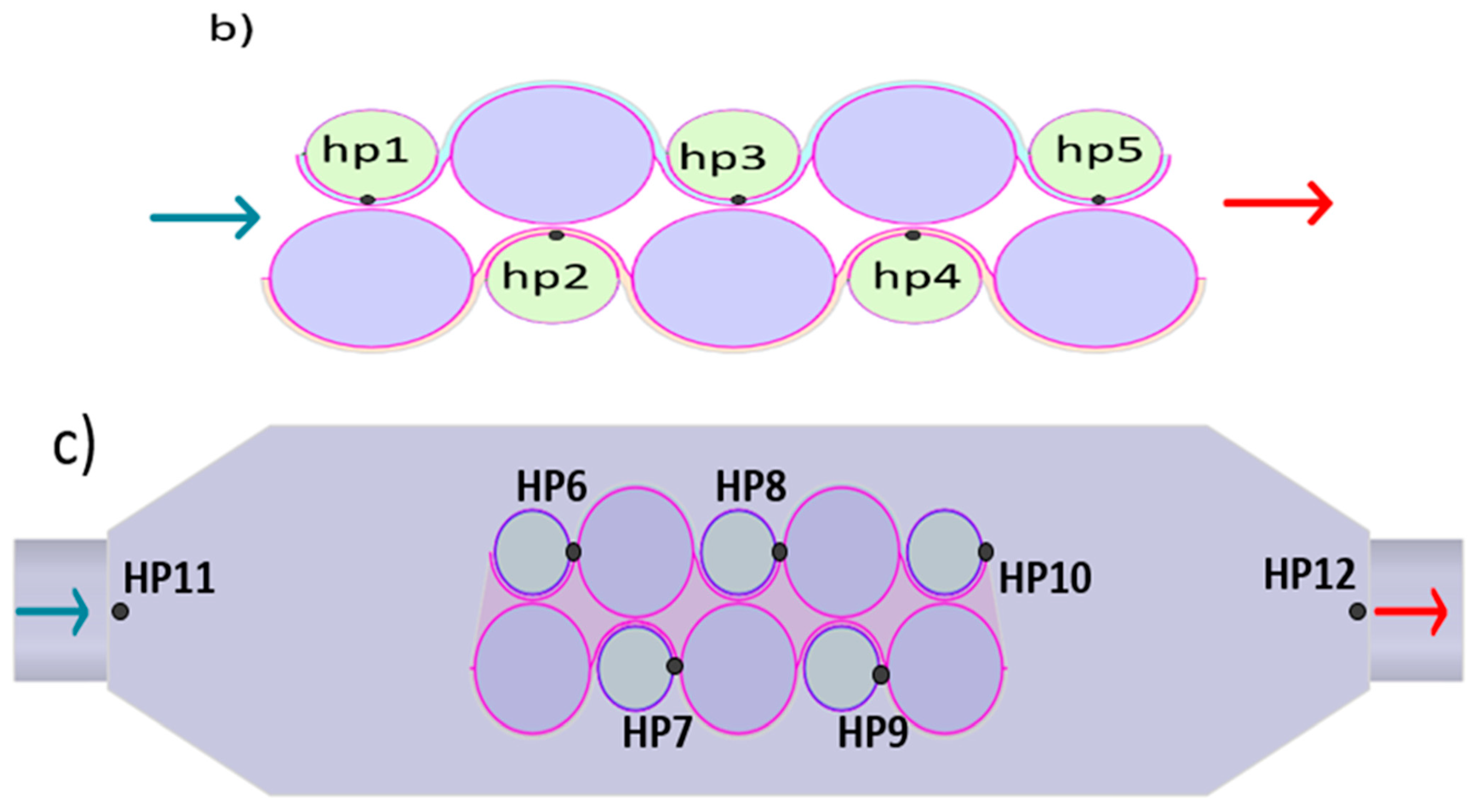

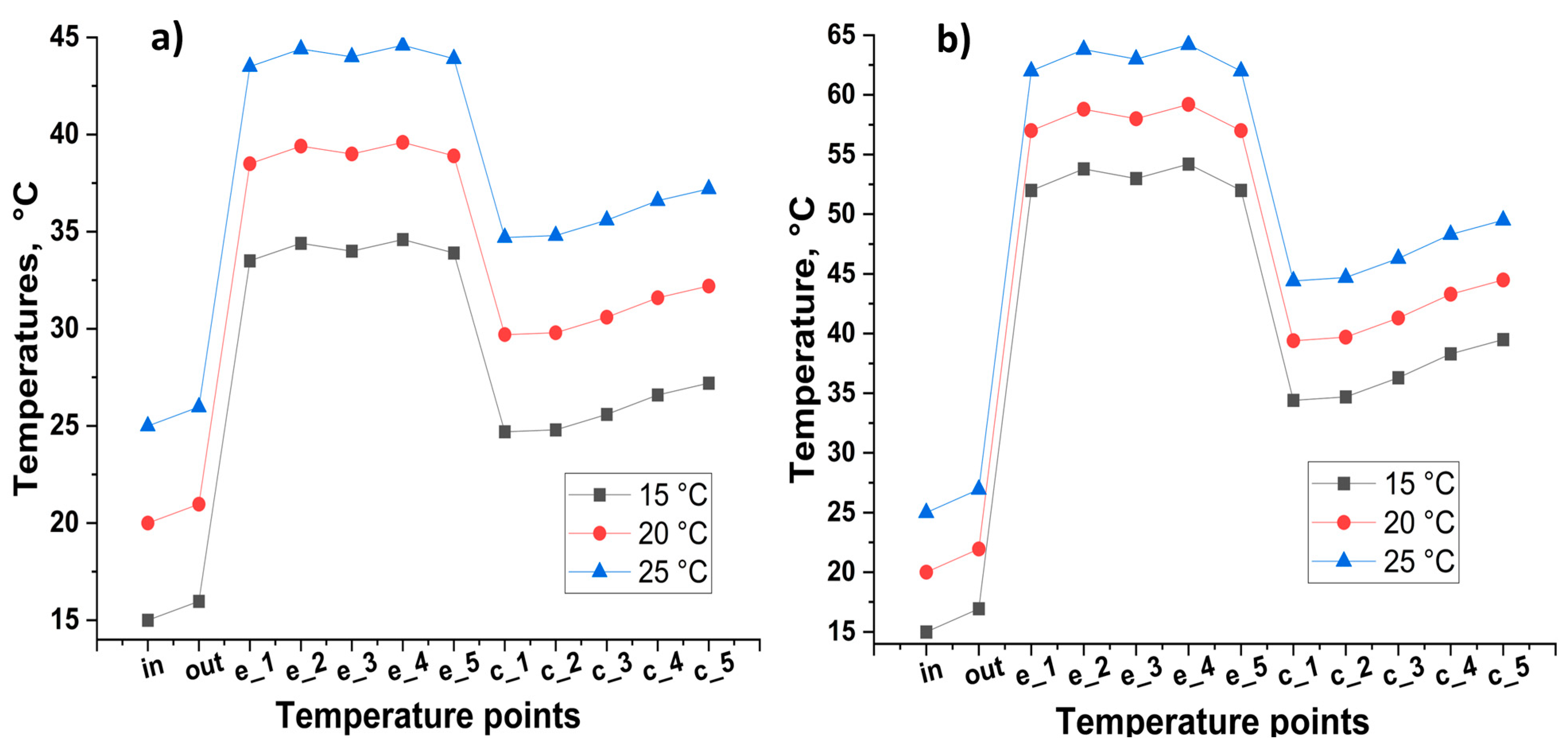
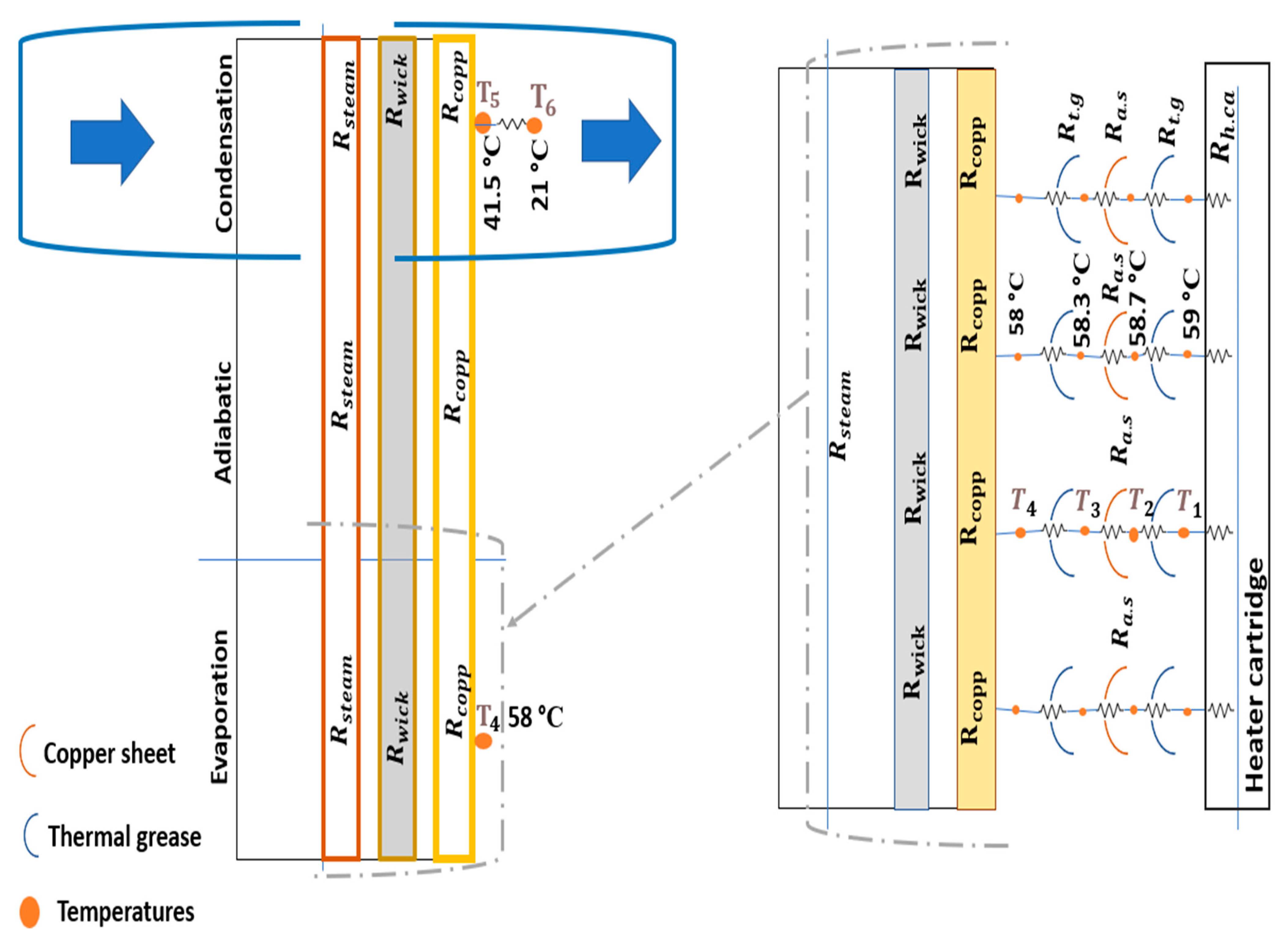
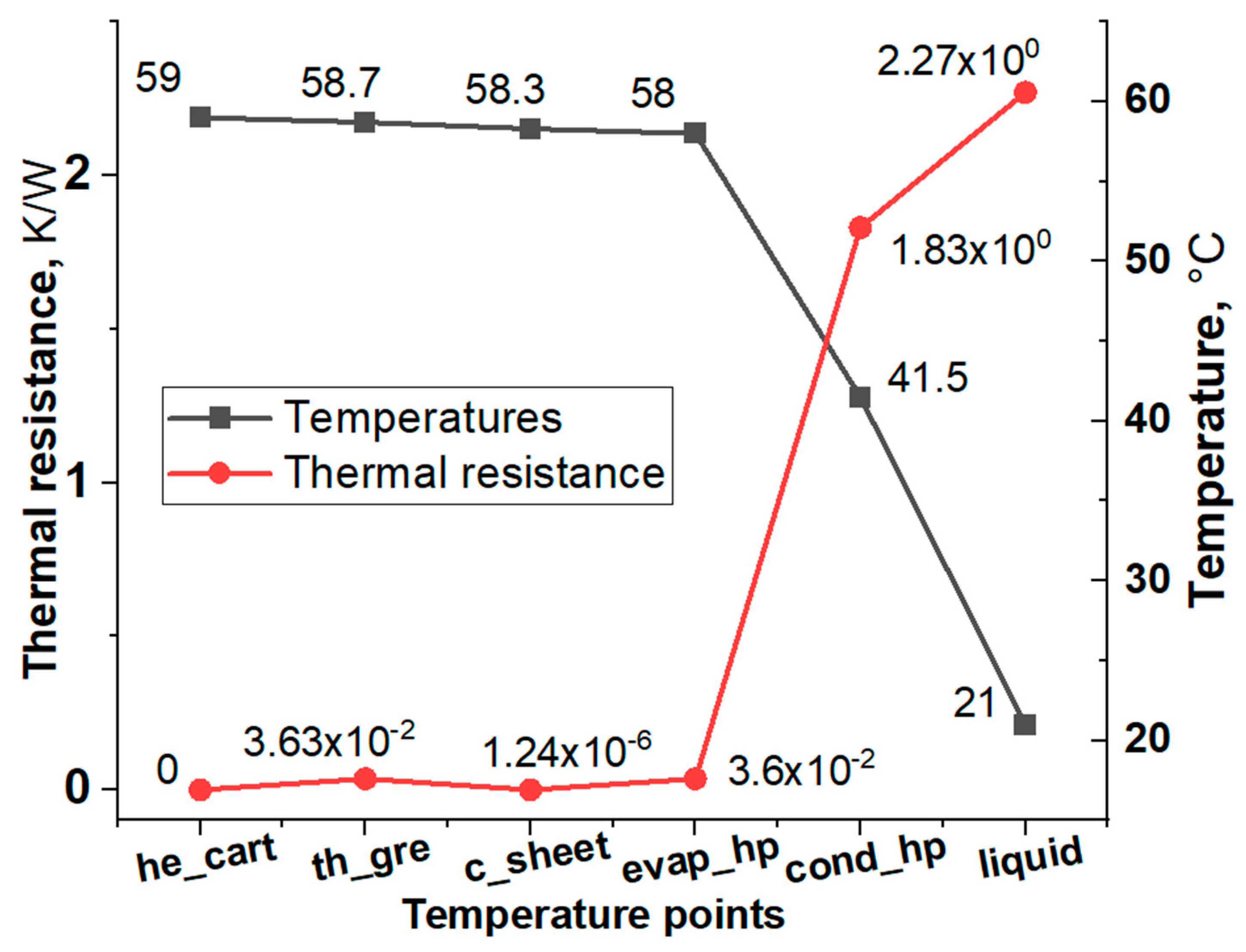
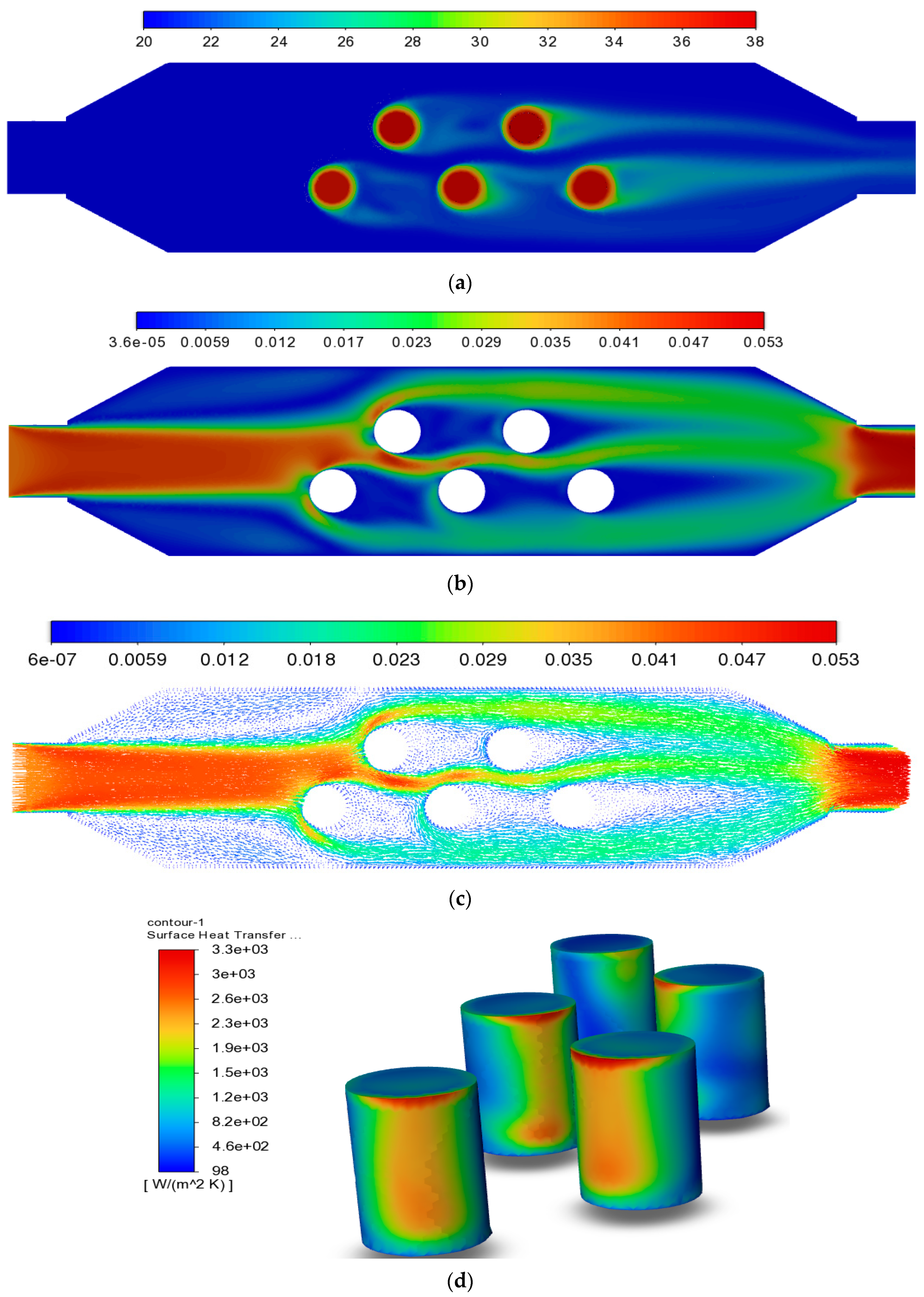
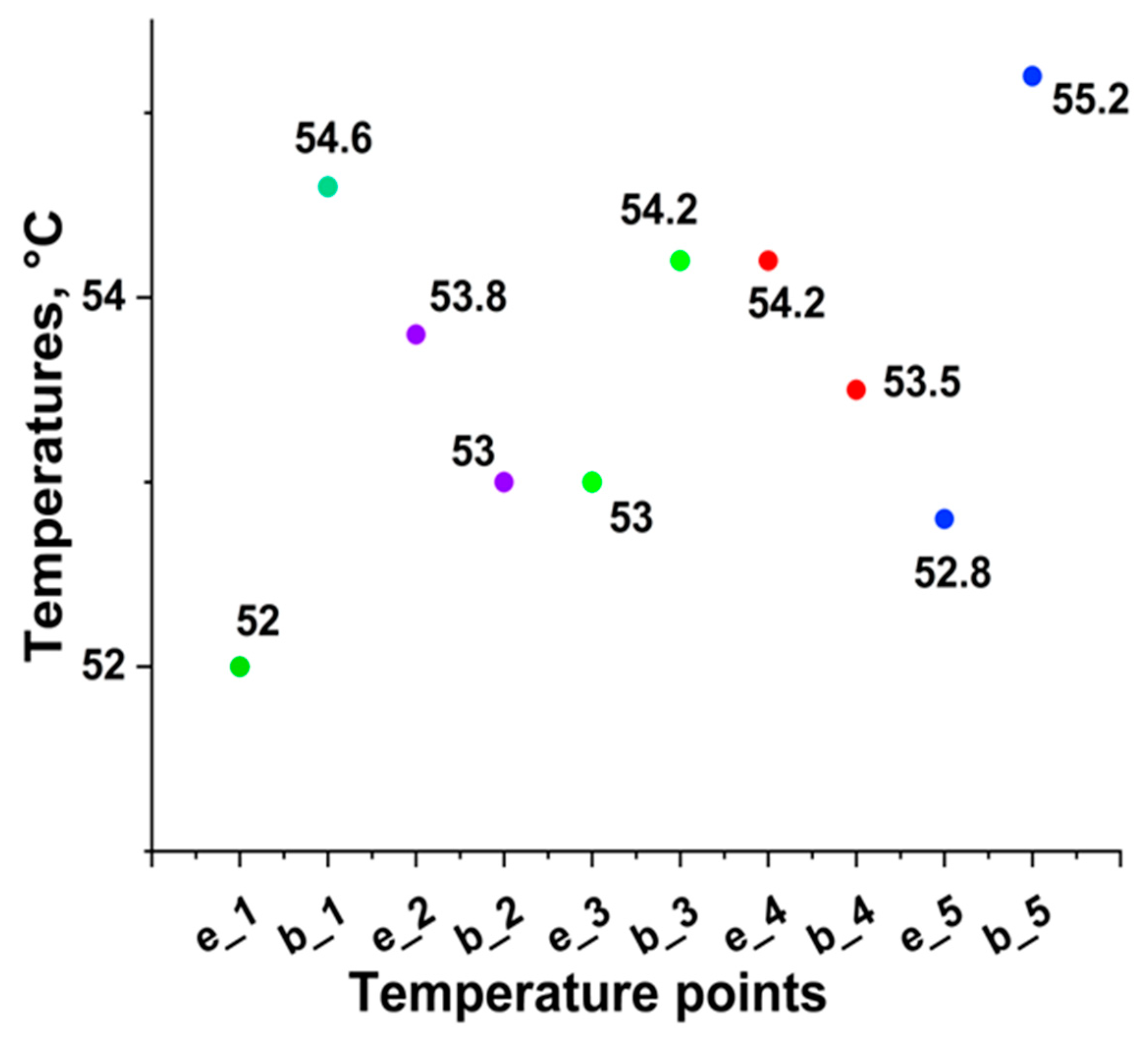
| Material | P (kg m−3) | K (W m−1 K−1) | Cp (J kg−1 K−1) |
|---|---|---|---|
| Air | 1.225 | 0.0242 | 1006 |
| Aluminum | 2719 | 202.4 | 871 |
| Copper | 8978 | 387.6 | 381 |
| Vapor | 0.03037 | 2,044,201 | 1874 |
| Wick | 3500 | 1.5 | 790 |
| Thermal grease | 1600 | 1.42 | 1700 |
| Part | Symbol | Equation |
|---|---|---|
| Thermal grease | L/ | |
| Copper sheet | ||
| Evap. Copper | ||
| Cond. Copper | ||
| Evap. Wick | ||
| Cond. Wick | ||
| Adiab. Wick | L/ | |
| Adiab. Copper | L/ | |
| Convective |
| Parameter | Values (mm) |
|---|---|
| Outer diameter, | 8 |
| Adiabatic length, | 62 |
| Evaporation length, | 75 |
| Condenser length, | 13 |
| Total length, | 150 |
| No | Heat Input | Flow Rate | Cooling Temperature |
|---|---|---|---|
| 1 | 5 W | 0.33 L/min | 15, 20, 25 °C |
| 2 | 10 W | 0.33 L/min |
| Parameters | Uncertainty |
|---|---|
| K-Type thermocouples | 0.6 °C |
| NI modules | 1% |
| DC power supply | 1.5% |
| Heater cartridges | 2% |
| Pressure device | 1% |
| Flow meter with valve | 1% |
Disclaimer/Publisher’s Note: The statements, opinions and data contained in all publications are solely those of the individual author(s) and contributor(s) and not of MDPI and/or the editor(s). MDPI and/or the editor(s) disclaim responsibility for any injury to people or property resulting from any ideas, methods, instructions or products referred to in the content. |
© 2023 by the authors. Licensee MDPI, Basel, Switzerland. This article is an open access article distributed under the terms and conditions of the Creative Commons Attribution (CC BY) license (https://creativecommons.org/licenses/by/4.0/).
Share and Cite
Burkitbayev, A.; Weragoda, D.M.; Ciampa, F.; Lo, K.H.; Tian, G. A Numerical and Experimental Investigation on a Gravity-Assisted Heat-Pipe-Based Battery Thermal Management System for a Cylindrical Battery. Batteries 2023, 9, 456. https://doi.org/10.3390/batteries9090456
Burkitbayev A, Weragoda DM, Ciampa F, Lo KH, Tian G. A Numerical and Experimental Investigation on a Gravity-Assisted Heat-Pipe-Based Battery Thermal Management System for a Cylindrical Battery. Batteries. 2023; 9(9):456. https://doi.org/10.3390/batteries9090456
Chicago/Turabian StyleBurkitbayev, Arman, Delika M. Weragoda, Francesco Ciampa, Kin Hing Lo, and Guohong Tian. 2023. "A Numerical and Experimental Investigation on a Gravity-Assisted Heat-Pipe-Based Battery Thermal Management System for a Cylindrical Battery" Batteries 9, no. 9: 456. https://doi.org/10.3390/batteries9090456
APA StyleBurkitbayev, A., Weragoda, D. M., Ciampa, F., Lo, K. H., & Tian, G. (2023). A Numerical and Experimental Investigation on a Gravity-Assisted Heat-Pipe-Based Battery Thermal Management System for a Cylindrical Battery. Batteries, 9(9), 456. https://doi.org/10.3390/batteries9090456








